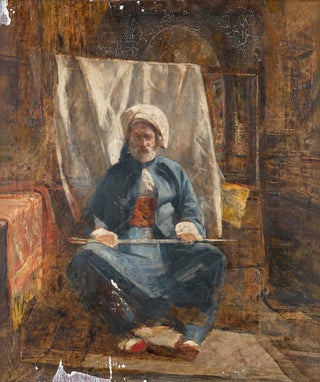Art print | Sketch for Cairo, Bezestein El Khan Khalil - John Frederick Lewis


View from behind

Frame (optional)
The artwork "Sketch for Cairo, Bezestein El Khan Khalil" by John Frederick Lewis is an invitation to immerse oneself in a world where Orientalism blends with the sensibility of a 19th-century British artist. This painting, a true reflection of the travels and discoveries of its time, captures a snapshot of daily life in Cairo while embodying the very essence of Egyptian culture. Lewis, through his exceptional talent, manages to transport the viewer to the heart of the souk, where vibrant colors and rich textures combine to create an atmosphere that is both intimate and captivating. The light, so characteristic of his style, plays a crucial role in this work, illuminating faces and landscapes in a way that seems almost magical.
Style and uniqueness of the work
John Frederick Lewis's style is distinguished by its meticulous realism and attention to detail. In this sketch, every element, from fabrics to the faces of characters, is rendered with a precision that borders on hyperrealism. The nuances of color, ranging from warm ochres to deep blues, evoke not only the heat of the Egyptian climate but also the region's cultural richness. The artist employs painting techniques that create delicate shadows and luminous reflections, adding an almost three-dimensional dimension to the scene. The composition itself, carefully crafted, guides the viewer's eye through the painting, inviting exploration of every corner of this lively scene. The fusion of tradition and modernity in his artistic approach makes this work an emblematic example of Orientalism, while revealing a unique sensitivity to the beauty of everyday life.
The artist and his influence
John Frederick Lewis, a major figure in Orientalism, captured the collective imagination of his era by presenting scenes of Eastern life through the lens of his own experience. Born in England, he traveled to Egypt, where he found an inexhaustible source of inspiration. His work not only influenced his contemporaries but also paved the way for a new appreciation of Eastern art in Europe.

Matte finish

View from behind

Frame (optional)
The artwork "Sketch for Cairo, Bezestein El Khan Khalil" by John Frederick Lewis is an invitation to immerse oneself in a world where Orientalism blends with the sensibility of a 19th-century British artist. This painting, a true reflection of the travels and discoveries of its time, captures a snapshot of daily life in Cairo while embodying the very essence of Egyptian culture. Lewis, through his exceptional talent, manages to transport the viewer to the heart of the souk, where vibrant colors and rich textures combine to create an atmosphere that is both intimate and captivating. The light, so characteristic of his style, plays a crucial role in this work, illuminating faces and landscapes in a way that seems almost magical.
Style and uniqueness of the work
John Frederick Lewis's style is distinguished by its meticulous realism and attention to detail. In this sketch, every element, from fabrics to the faces of characters, is rendered with a precision that borders on hyperrealism. The nuances of color, ranging from warm ochres to deep blues, evoke not only the heat of the Egyptian climate but also the region's cultural richness. The artist employs painting techniques that create delicate shadows and luminous reflections, adding an almost three-dimensional dimension to the scene. The composition itself, carefully crafted, guides the viewer's eye through the painting, inviting exploration of every corner of this lively scene. The fusion of tradition and modernity in his artistic approach makes this work an emblematic example of Orientalism, while revealing a unique sensitivity to the beauty of everyday life.
The artist and his influence
John Frederick Lewis, a major figure in Orientalism, captured the collective imagination of his era by presenting scenes of Eastern life through the lens of his own experience. Born in England, he traveled to Egypt, where he found an inexhaustible source of inspiration. His work not only influenced his contemporaries but also paved the way for a new appreciation of Eastern art in Europe.






